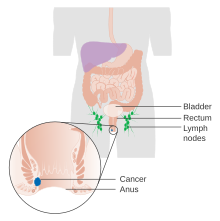
Back Anale kanker AF سرطان الشرج Arabic سرطان الشرج ARZ Càncer anal Catalan Analkarzinom German Cáncer de ano Spanish سرطان مقعد FA Peräaukon syöpä Finnish Cancer de l'anus French סרטן פי-הטבעת HE
| Anal cancer | |
|---|---|
 | |
| Diagram showing stage 1 anal cancer | |
| Specialty | Oncology |
| Symptoms | Anal bleeding or lump[1] |
| Usual onset | Age over 45 years[2] |
| Types | Squamous cell carcinoma, adenocarcinoma, small cell carcinoma, melanoma[3] |
| Risk factors | Human papillomavirus (HPV), HIV/AIDS, receptive anal sex, smoking, many sexual partners[1][4] |
| Diagnostic method | Physical examination, tissue biopsy[1] |
| Differential diagnosis | Anal warts, hemorrhoids, anal fissure[5] |
| Prevention | HPV vaccination, avoiding risk factors[6] |
| Treatment | Radiation therapy, chemotherapy, surgery[1] |
| Prognosis | Five year survival ~68% (US 2015)[2] |
| Frequency | 8,300 (US 2019)[2] |
| Deaths | 1,280 (US 2019)[2] |
Anal cancer is a cancer which arises from the anus, the distal opening of the gastrointestinal tract.[1] Symptoms may include bleeding from the anus or a lump near the anus.[1] Other symptoms may include pain, itchiness, or discharge from the anus.[1] A change in bowel movements may also occur.[1]
Risk factors include human papillomavirus (HPV), HIV/AIDS, receptive anal sex,[4] smoking, and many sexual partners.[1] Anal cancer is typically a squamous cell carcinoma.[3] Other types include adenocarcinoma, small cell carcinoma, and melanoma.[3] Diagnosis is suspected based on physical examination and confirmed by tissue biopsy.[1]
Prevention includes avoiding risk factors and HPV vaccination.[6] Standard treatment may include radiation therapy, chemotherapy, and surgery.[1] About 8,300 people are diagnosed a year in the United States, representing about 0.5% of new cancers.[2] Onset is typically after the age of 45.[2] Women are affected more often than men.[2] The number of cases has increased since the 1990s.[3] The five-year survival rate in the United States is 68%.[2]
- ^ a b c d e f g h i j k "Anal Cancer Treatment". National Cancer Institute. 2018. Retrieved 30 May 2019.
- ^ a b c d e f g h "Cancer of the Anus, Anal Canal, and Anorectum—Cancer Stat Facts". SEER. Retrieved 30 May 2019.
- ^ a b c d Nelson, VM; Benson AB, 3rd (January 2017). "Epidemiology of Anal Canal Cancer". Surgical Oncology Clinics of North America. 26 (1): 9–15. doi:10.1016/j.soc.2016.07.001. PMID 27889039.
{{cite journal}}: CS1 maint: numeric names: authors list (link) - ^ a b Daling, Janet; et al. (1987). "Sexual Practices, Sexually Transmitted Diseases, and the Incidence of Anal Cancer". The New England Journal of Medicine. 317 (16): 973–977. doi:10.1056/NEJM198710153171601. PMID 2821396.
- ^ Garden, O. James; Bradbury, Andrew W.; Forsythe, John L. R.; Parks, Rowan W. (2012). Principles and Practice of Surgery E-Book. Elsevier Health Sciences. p. 272. ISBN 9780702051166.
- ^ a b "Anal Cancer Prevention". National Cancer Institute. 14 February 2014. Retrieved 30 May 2019.